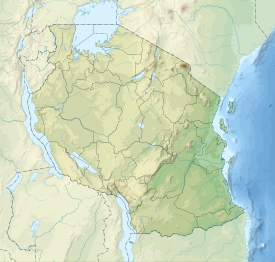Songo Mnara
| Songo Mnara | |
|---|---|
| Location | Tanzania |
| Coordinates | 9°2′58″S 39°34′2″E / 9.04944°S 39.56722°ECoordinates: 9°2′58″S 39°34′2″E / 9.04944°S 39.56722°E |
On the Swahili Coast in southern Tanzania lie the ruins of a stone town known as Songo Mnara. The stone town was occupied from the 14th to 16th centuries. Songo Mnara has been recognized at a UNESCO World Heritage Site, along with nearby stone town Kilwa Kisiwani. In total, archaeologists have found six mosques, four cemeteries, and two dozen house blocks along with three enclosed open spaces on the island. Songo Mnara was constructed from rough-coral and mortar. This stonetown was built as one of many trade towns on the Indian Ocean.
Archaeologists have been analyzing the layout of stone towns on the Swahili coast, mainly focusing on the relationship of the mosques and houses, in order to understand the role of the Swahili coast in Islamic culture, the functions of specific towns, and the complex economic and ritual process of land ownership. Open spaces in towns were used for both functional purposes for social organization. Cemeteries are found both inside and outside the town walls. The layout of Songo Mnara is typical of stone towns along the Swahili coast, though its wall is a unique feature.
Excavations have helped archaeologists to better understand ways of life at Songo Mnara. Many different areas have been excavated, including several of the more than 40 houses found surrounding the stone town. Trenches were dug in House 44, House 23 outside the houses, by a tomb, and a well. Many different types of artifacts have been found, although few were recovered from within the excavated houses. Archaeologists carefully mapped and recorded their finds.
House 44 was an important area of research because of the complexity of the rooms and the fact that it was an individual’s house. This house had excavations in each room, each trench having a different number. There was a 1 x1 m test unit on the southwest room, dug slowly because of the layers of ceramics. This excavation stopped when they hit the level of plaster underneath the floor. There was another located on the south-west side of the house which was approximately 4 x 2.25m. There were also ceramics found in this room. The next room was in the center of the house, where they found plaster and coral among the layers of rubble. In this room, they stopped excavations at the plaster floor. There were also excavations done at entrance room, southeastern room, and the back room of the house. The ceramics found at house 44 were from the 15th century.
House 23 is located in the southwestern corner of Songo Mnara. Due to time constraints, this house only had samples taken from it instead of excavating it completely. A 4 x 1m unit was put in the courtyard of the house. During excavations, steps were uncovered, along with floor made out of coral bedrock. The next room was a central room which had a 2 x 2m unit placed. There was no plaster floor like what was found at House 44.
...
Wikipedia

